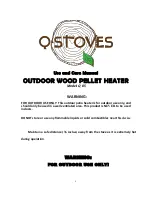
Figure 29
IMPORTANT
KEEP ASH DRAWER EMPTY. IF ASHES ARE PERMITTED
TO BUILD UP ABOVE THE GRATE, THE GRATES COULD
WARP AND EVENTUALLY BURN OUT.
DANGER
NEVER BURN MATERIALS OTHER THAN WOOD LOGS,
PREFERABLY SPLIT AND DRIED.
A CHIMNEY FIRE OR HEAT EXCHANGER FAILURE
COULD RESULT. THIS INCLUDES LARGE AMOUNTS
OF CORRUGATED BOXES, WOODSHAVINGS, PAPER
SCRAPS, DRIED CHRISTMAS TREES, COAL, GARBAGE,
TIRES OR OTHER BURNABLE PRODUCTS.
IMPORTANT
DURING NORMAL OPERATION, FIRING DOOR
AND ASH DOOR MUST BE KEPT TIGHTLY
CLOSED. AIR LEAKAGE WILL CAUSE LOSS OF
EFFICIENCY RESULTING IN HIGHER HEATING
COSTS. IF DOOR GASKETS BECOME WORN,
REPLACE WITH 5/8” AND 1/2” CERAMIC
ROPE AVAILABLE FROM LOCAL SOURCES.
BOX 422 • TOWER, MN 55790 • USA • Tel (218) 753-2330 • www.lamppakuuma.com
17
DOS AND DONT’S OF OPERATION
Wood Firing the Unit
Rake hot coals
to the FRONT as
shown, DO NOT
BLOCK PRIMARY
AIR OPENINGS.
Keep coals
approximately 1”
from front air inlets.
HOT COALS
ASHES
HOT
COALS
ASH PAN
RAKE
A
I
R
P
R
I
M
A
R
Y
Figure 30
Periodically remove ashes from the ash pan via the ash pan door
(see figures 17, 26, 29, and 30). Always dispose of ashes in a
metal container with a tight metal cover. Do not store ashes in-
side your house. Always store the metal ash container in a well
ventilated area or outdoors as ashes may contain live coals (em-
bers) which may emit carbon monoxide. Do not place the metal
ash container next to anything combustible. Pour some water in
the container, but do this outdoors in case of live embers. Stir
the ashes to distribute the water. Allow at least 3 days for water
to fully penetrate all ashes before bagging ashes and disposing
in the trash. Make sure you are complying with all local ordi-
nances relating to wood-ash disposal. Many local landfill sites
have ash disposal containers.











































